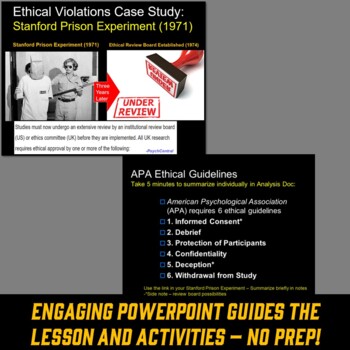Stanford Prison Experiment: Case Study in Ethics - Engaging Analysis Lesson
- Zip
- Internet Activities
What educators are saying
Description
Nothing captures students attention more in Psychology or Sociology than the infamous and controversial 1971 Stanford Prison Experiment. However, the recent uncovering of primary source recordings found Zimbardo's team coaching the prison guards to ramp up abusive behavior. This has further delegitimized many of the original conclusions on human behavior found in this already controversial experiment. Should we stop teaching this largely debunked study? Not so fast.
What we are left with is the cornerstone case study to ethical violations and ethical guidelines established by the American Psychological Association (APA) three years after the Stanford Prison Experiment. This lesson teaches and applies ethics in Psychology by analyzing how the majority of ethical guidelines were repeatedly violated in the Stanford Prison Experiment.
In this Google Doc guided lesson/activity, students complete the following process:
1. Quickly summarize the six major ethical guidelines in the Google Doc Analysis using a quick article or provided slides
2. Watch a 14 minute engaging documentary on the Stanford Prison Experiment
3. Complete Google Doc analysis of ethical violations (makes for a great discussion or collaborative activity)
4. Apply the ethical violations to another student favorite, the Bystander Effect (3-minute clip provided)
Overall, this lesson package includes:
-Student Google Doc Analysis - Editable, shareable, and Distance-learning friendly. Students follow along with the entire lesson to promote engagement (prep free)
-YouTube Documentary Teacher Viewing Guide and Video Link - There are three scenes identified where language/footage inappropriate for some classrooms may be skipped at the teacher's discretion (an alternative article is also supplied)
-Teacher PowerPoint Slides - Guides the lesson and includes additional visuals/links (PDF version also included)
-Answer Key - Embedded in PowerPoint and in a separate Google Doc
-Bonus - link to article/audio file of Zimbardo's team coaching prison guards
If you enjoy this lesson, check out some of my other favorite Psychology activities:
-Sensation & Perception Brain Game Activities
-Loftus-Palmer Car Crash Experiment Simulation
-Psychology's Seven Modern Perspectives
-Face Blindness Brain Game - Sensation/Perception
-Altered States of Consciousness Jigsaw Activity





